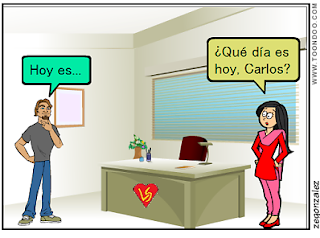Introduction
Verbo: Poner
Tipo: irregular
Modo: indicativo
Tiempo: pretérito
indefinido
(simple past)
This
post is about verb conjugation -the preterite tense,
indicative mood of irregular verb poner.
SCENARIO
Imagine
you are at home with some relatives, friends or colleagues. You are
about to eat and the table needs setting. Someone wants to know who
set the table the day before and says to you: "tell me, who
set the table yesterday?"
In
Spanish, the other person could choose to be less formal and say:
Dime,
¿quién puso la mesa ayer?
On the
other hand, he/ she could choose to be more formal and say:
Dígame,
¿quién puso la mesa ayer?
OUR
TIP
Making a sentence
which answers that question should be straightforward, but remember:
Typical answers
could be:
Yo
puse*
la mesa ayer (I
set the table yesterday)
Tú
pusiste*
la mesa ayer, ¿no? (you
-familiar
set
the table yesterday, didn't you?)
Usted
puso*
la mesa ayer, ¿no? (you
-formal
set
the table yesterday, didn't you?)
Pedro
puso*
la mesa ayer (Pedro
set
the table yesterday)
María
puso*
la mesa ayer (Maria
set
the table yesterday)
Pedro
y yo
pusimos*
la mesa ayer (Pedro
and I set
the table yesterday)
Vosotros
pusisteis*
la mesa ayer, ¿no? (you
people -familiar/
plural set
the table yesterday, didn't you?)
Ustedes
pusieron*
la mesa ayer, ¿no? (you
people -formal/
plural set
the table yesterday, didn't you?)
Pedro
y María pusieron*
la mesa ayer (Pedro
and María set
the table yesterday)
Now you should
practise replying to someone who says to you:
Dime,
¿quién puso la mesa ayer?
*Please
see grammar topic below, Verbs
Verbs
A verb is a 'doing'
word which conveys:
In
addition, the verb may also convey the mood
or feelings of the speaker toward the action which takes place. The
verb may, for example, indicate whether the speaker is stating a
fact, expressing a wish or indeed giving an order.
Irregular
Verbs
Verb:
poner
The
Spanish verb poner is irregular* in some tenses, as
shown in the table below:
Tense
|
Mood
|
Regular
|
Irregular
|
Present
|
Indicative
|
|
✓
|
Imperfect
|
Indicative
|
✓
|
|
Preterite
|
Indicative
|
|
✓
|
Future
|
Indicative
|
|
✓
|
Conditional
|
Indicative
|
|
✓
|
Perfect
|
Indicative
|
|
✓
|
Pluperfect
|
Indicative
|
|
✓
|
Future
Perfect
|
Indicative
|
|
✓
|
Conditional
Perfect
|
Indicative
|
|
✓
|
Present
|
Subjunctive
|
|
✓
|
Imperfect
|
Subjunctive
|
|
✓
|
Perfect
|
Subjunctive
|
|
✓
|
Pluperfect
|
Subjunctive
|
|
✓
|
* NB:
Indicative
Mood/ Preterite Tense - Conjugation
Verb:
poner
Subject
|
PONER
(TO
PUT)
|
| I |
Yo
|
PUSE
|
| You |
Tú
|
PUSISTE
|
| You |
Usted* |
PUSO
|
| He |
Él |
| She |
Ella
|
| We |
Nosotros
|
PUSIMOS
|
| You |
Vosotros**
|
PUSISTEIS
|
| You |
Ustedes***
|
PUSIERON
|
| They |
Ellos
|
| They |
Ellas
|
*NB
More courteous/ polite form of 'you'
**NB
'You' plural
***
NB More courteous/ polite form of 'you' plural
Verb
Conjugation Notes
It
is worth remembering once more that in its basic form (infinitive),
a Spanish verb is just a general 'doing' word. In that form, a verb
simply indicates an action and nothing else. If we want a verb to be
more specific about the action in a sentence, we need to conjugate
it. It is only when conjugated that the verb indicates:
The conjugation
tables above refer to using conjugation to establish who does
the action. What follows below are some notes on establishing when
the action takes place and the mood/ attitude of the speaker
towards the action.
Subjunctive
Mood
The
use of subjunctive
mood
is disappearing English. Nowadays is often viewed as an old and
unfashionable form of the language.
In contrast, the
use of subjunctive mood is very much alive and in everyday use
in Spanish. This widespread use of subjunctive mood tends to be the
bane of many a learner of Spanish from the English speaking world.
The
concept of subjunctive
mood
is perhaps best illustrated by contrasting its use against the use of
indicative mood with examples in English. The following are a couple
of examples which should serve that purpose:
Indicative
mood (“Peter eats an apple”).-
Indicative mood is commonly used to make statements of facts or
positive beliefs such as this one. As can be seen in the sample
sentence (in quotes above), the speaker makes a clear and
unambiguous statement
of a fact (Peter
eats an apple).
Subjunctive
mood (“Peter would eat an apple if he were hungry”).-
In contrast with indicative mood, subjunctive mood is commonly used
to make statements indicating hypothetical or non-fact actions. As
can be seen in the sample sentence (in quotes), in this case the
speaker sees the action of eating an apple as something
hypothetical,
something which may or may not happen (Peter would eat an apple...
if he were hungry).
Verb
Tenses
Verb tenses relate
to setting the time period (when) during which the action of
the verb takes place. Basic times (periods) for Spanish verb actions
are:
The past (before
now)
The present (now)
The future (after
now)
Each
Spanish verb tense corresponds to one of those basic time periods. In
other words choosing a verb tense places the action of the verb in
one of those basic periods and determines when
the action takes place.
Now
you should practise the use of the preterite tense of the
irregular verb poner with some examples of your
own.
Spanish
lessons online
Skype/
Google+ Hangout/ Facetime
Great
lessons
©
Copyright 2015 Love-Spanish.com
by Jose M González. All Rights Reserved.












